Do you and your horse enjoy rugged trail rides? Or competitions that feature “extreme” trail challenges? If so, you’ll benefit from the tips and exercises on these pages. I use them to prepare for the Appaloosa Horse Club’s Chief Joseph Trail Ride, a formidable multiple-day journey that retraces the 1877 “flight to freedom” of the Nez Perce Indians.
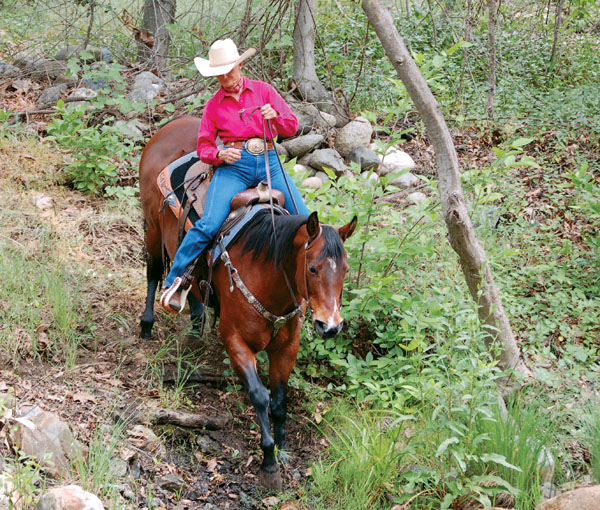
Over the years, as the ride works its way from Oregon through Idaho and Wyoming to northern Montana, riders face the challenges of varying terrain and obstacles. Steep hills, narrow trails, water crossings, and deadfalls are all common.
Using a little creativity and working mostly at home, you can ready your horse for these types of obstacles; I’ll show you how. And, even if tough trails aren’t for you, this work is terrific training for your horse. It’ll strengthen the connection between the two of you, plus it’s a lot of fun.
Ready? Let’s go.
Make a Splash
Trail challenge: Water crossings. The very words can send chills up your spine if you don’t frequently ride your horse through streams and rivers. But, if you want to go on major trail rides, you will cross water, so get ready for it.
Tame it: By getting your horse’s feet (and more!) wet, a little at a time.
Here’s how: The most logical practice involves natural creeks or streams near you. Enlist the help of a friend with trail experience, as the easiest approach is to follow the lead of a horse that doesn’t hesitate at water. If a stream isn’t available, a lake or pond can substitute. If you don’t have a seasoned horse to follow, ride back and forth at the water’s edge, with turns that get you closer and closer to the water until your horse’s feet start touching it. Let your horse sniff the water, then keep urging him through it.
Make-it-work tips: Be patient and give your horse time to discover the water won’t hurt him. You can even start this work right at home, using a 4-by-4-foot water box (see photo). Build one of 2-by-6-inch pressure-treated planks, with a 1-inch plywood bottom; caulk all seams, then add water just before use. Take the time that’s needed to get your horse to step into and through the water box calmly. Your goal is to make water no big deal.
Step Over and Through
Trail challenge: Deadfalls. Consisting of logs and fallen tree branches that cover the trail, deadfalls are common on real-world rides. I’ve ridden over several that were belly-high to my horse.
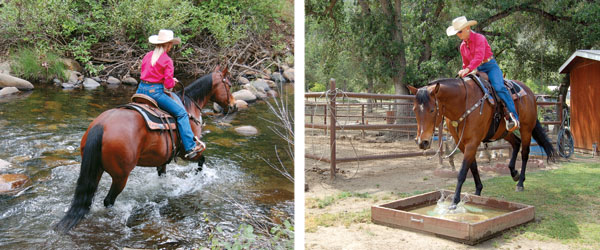
Tame it: By practicing on deadfalls you create yourself.
Here’s how: Build your practice deadfall using railroad ties and/or downed tree limbs, staggering their positioning. Start with the pieces all lying flat on the ground; then, as your horse becomes accustomed to picking his way through, gradually raise some of the pieces on top of others (see photo). Your horse must learn to figure out how to navigate a deadfall, so encourage him to drop his head and examine it, giving him time to think things through.
Make-it-work tips: If your horse is really hesitant, start with just a few ties or small logs spaced out as on a trail-class course, then gradually bring them closer together and start crossing them and building them up. Remember, trees come in all sizes, so you must accustom your horse to picking up his feet higher than he must for a simple log crossing.Dig In, Climb Up, Inch Down
Trail challenge: Steep hills. Horses typically handle moderate hills easily, but trail blockages can sometimes require even steeper ascents—and descents, which can be more daunting.
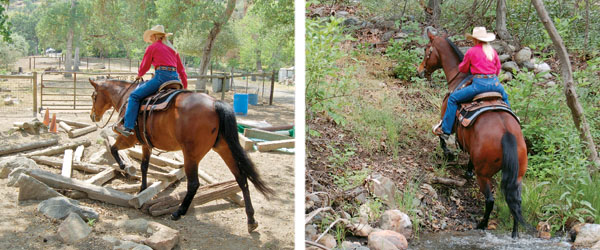
Tame it: By finding and mastering some real hills.
Here’s how: Drawing again on that trail-veteran friend, haul with him or her to a locale that offers different-size hills to practice on. Horses often want to hurry up and down slopes, so insist that your horse go slowly and pick his way carefully right from the start. Following your trail-veteran friend should make this doable. Going downhill on steeper slopes, zigzag initially to lessen the angle, gradually asking for a more direct descent—one step at a time, if need be. Once your horse is comfortable on hills of various height and slope, ask for a few back-up steps as well, going both up and down. You never know when backing up a few paces will be your only option to avoid an impassable obstacle or get around a horse that freezes on a narrow trail.
Make-it-work tips: Be sure to check that your cinch is snug before any hill work (and outfit your horse in a breast collar, if necessary, to keep your saddle in place). If your horse tries to rush either up or down, make him stop and wait—repeatedly, if need be—until he learns to proceed rhythmically and deliberately at the pace you choose.
Slog Through It
Trail challenge: Bogs. Though not common, marshy areas will eventually turn up on real-world trails. Even horses willing to cross clear water often balk at mud and moist ground that sinks beneath them.

Tame it: By practicing on variable footing that mimics a bog.
Here’s how: A handy substitute for a bog is your manure pile (see photos). As with all obstacles, proceed slowly, allowing your horse to pick his way carefully, one step at a time.
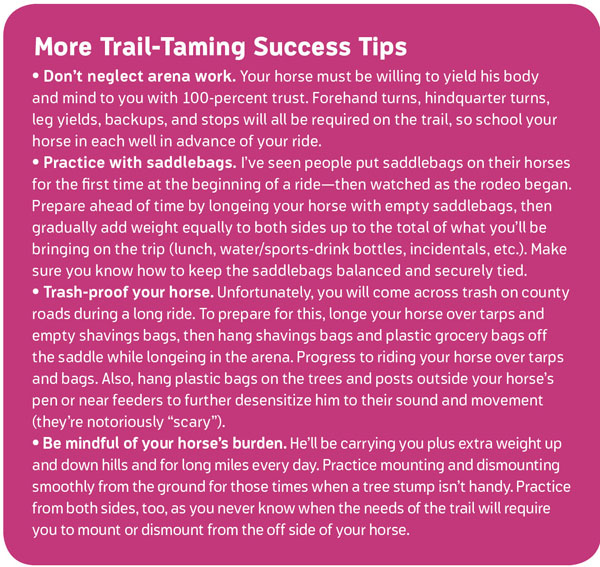
Make-it-work tips: Go back and forth through the pile, giving your horse ample time to accustom to the feel of unstable ground. Eventually, ask him to stop and turn around in the middle of the pile rather than simply crossing to the other side. Keep practicing until he no longer hesitates to step into and walk through the pile.
Control Each Step
Trail challenge: Tight spaces (as between trees or boulders), narrow trails, and trailside drop-offs that require your horse to stay calm and proceed carefully.
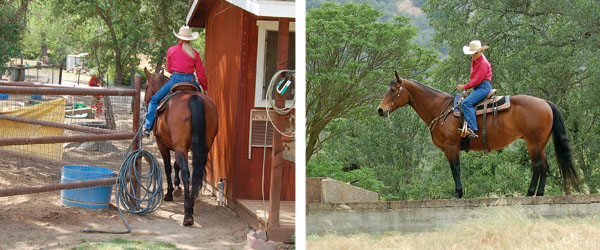
Tame it: With practice going through tight spaces and standing quietly next to drop-offs.
Here’s how: Make use of a narrow passageway you have available or can create at your barn (see photo). Your horse must learn that when space is tight, he waits for your signal to ease his way through, so his default is to pause rather than rush. For “cliff practice,” find a place that has some sort of drop, such as a raised step or an old building foundation (see photo), or even a dirt mound or the side of a hill. Move your horse slowly into position next to the drop-off, then ask him to stand calmly next to it for increasing periods of time, up to a few minutes.
Make-it-work tips: With narrow spaces, proceed one step at a time at first, pausing for a moment between each step. With drop-offs, start low and work up if possible to greater heights.
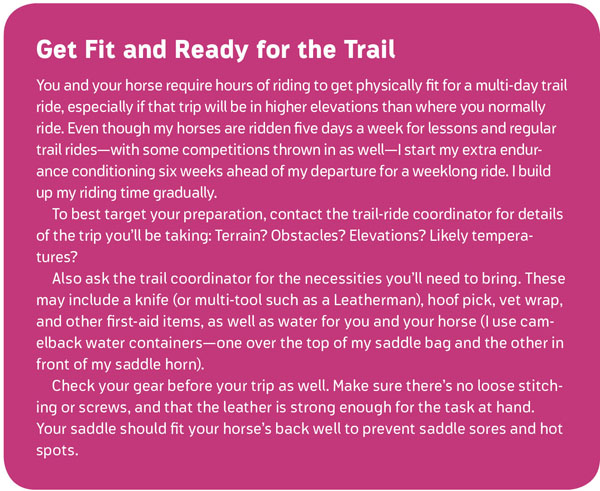
Christy Wood is a multi-carded judge, world champion trainer, extreme-cowboy-race competitor, and avid trail rider. At press time, she was preparing to go on the ApHC’s Chief Joseph Trail Ride for the 12th year in a row. Learn about her clinics on trail riding and women’s fitness (held at her Wood ’N’ Horse Ranch in Three Rivers, California) at wdnhorse.com.






